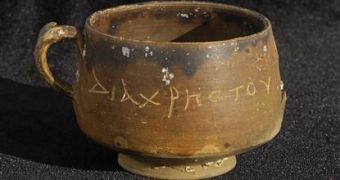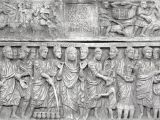Archaeologists discovered an ancient bowl, dated 2nd century BC to early 1st century AD, engraved with an inscription that refers to Christ, the earliest one found to date.
The carving on the bowl reads "DIA CHRSTOU O GOISTAIS," which can be translated either as "by Christ the magician" or "the magician by Christ." It was discovered by a group of French marine archaeologists, led by Franck Goddio, during an underwater excavation of the ruins of an ancient harbor in Alexandria, Egypt, which is also the place that may have hosted Cleopatra's palace. It is not known (and there is little probability that much evidence can be gathered in order to change that) whether the inscription refers to the biblical character of Jesus Christ, but if this is the case, then it further proves that Christianity and paganism evolved together during that period, 2 millennia ago.
The author of the discovery, Franck Goddio, co-founder of the Oxford Center of Maritime Archaeology, said: "It could very well be a reference to Jesus Christ, in that he was once the primary exponent of white magic." But, since the bowl strikingly resembles some others which were found in 2 ancient Egyptian earthenware statuettes linked to some soothsaying rituals, the researchers believe it might also have been used for such purposes. A "magus" of those days practiced fortune-telling using this kind of bowls and, as the Book of Matthew says, these "wisemen" (or Magi) were prevalent at that time.
Referring to the habit of soothsaying, Egyptologist David Fabre, a member of the European Institute of Submarine Archeology and a colleague of Goddio's during the discovery, explains that "It has been known in Mesopotamia probably since the 3rd millennium B.C. The soothsayer interprets the forms taken by the oil poured into a cup of water in an interpretation guided by manuals," as he enters a hallucinating trance. "They therefore see the divinities, or supernatural beings appear that they call to answer their questions with regard to the future," he added.
But then again, as Goddio states, "It is very probable that in Alexandria they were aware of the existence of Jesus," as well as of the legends that accompanied his name, such as the transformation of water into wine, water walking, multiplying bread and fish, curing miraculous illness or the resurrection event.
Some experts have come up with different theories that don't rule out the Jesus Christ approach though, such as a professor of classical archeology and art from Oxford University, Bert Smith, who says that the carving might have been an offering or a dedication from a "Chrestos", who was part of a certain religious group called Ogoistais, worshiping Hermes, Athena, Isis or other early Greek and Egyptian gods. Pausanias and Strabon were among the historians of those times who provide references to a god named "Osogo" or "Ogoa", which may lead to yet another approach by name association. As Fabre's conclusion points out, "It should be remembered that in Alexandria, paganism, Judaism and Christianity never evolved in isolation. All of these forms of religion (evolved) magical practices that seduced both the humble members of the population and the most well-off classes."
The bowl bearing the first possible reference to Jesus Christ in the world's history is on public display until November 15, as part of the exhibit called "Egypt's Sunken Treasures" taking place at the Matadero Cultural Center in Madrid, Spain. But there are other pieces of evidence associating Jesus Christ to a magus, such as the Vatican-held Roman sarcophagus stone plate carvings depicting a series of miracles performed by the magician. In the image below, there is such an item from the basilica of San Sebastiano, recorded under the number 31509 in the Vatican's inventory.
Front of sarcophagus: Peter strikes a rock with his wand, yielding water to baptize his jailers. Arrest of Peter. Miracle at Cana (water into wine). Female orant. Healing a blind boy. Multiplication of loaves (no fish). Resurrection of Lazarus and supplication of Lazarus’s sister.
The sarcophagus shelters the remains of "the deserving husband Sabino, who lived 44 years, 10 months and 13 days, in peace, laid to rest on April 26."

 14 DAY TRIAL //
14 DAY TRIAL // 
